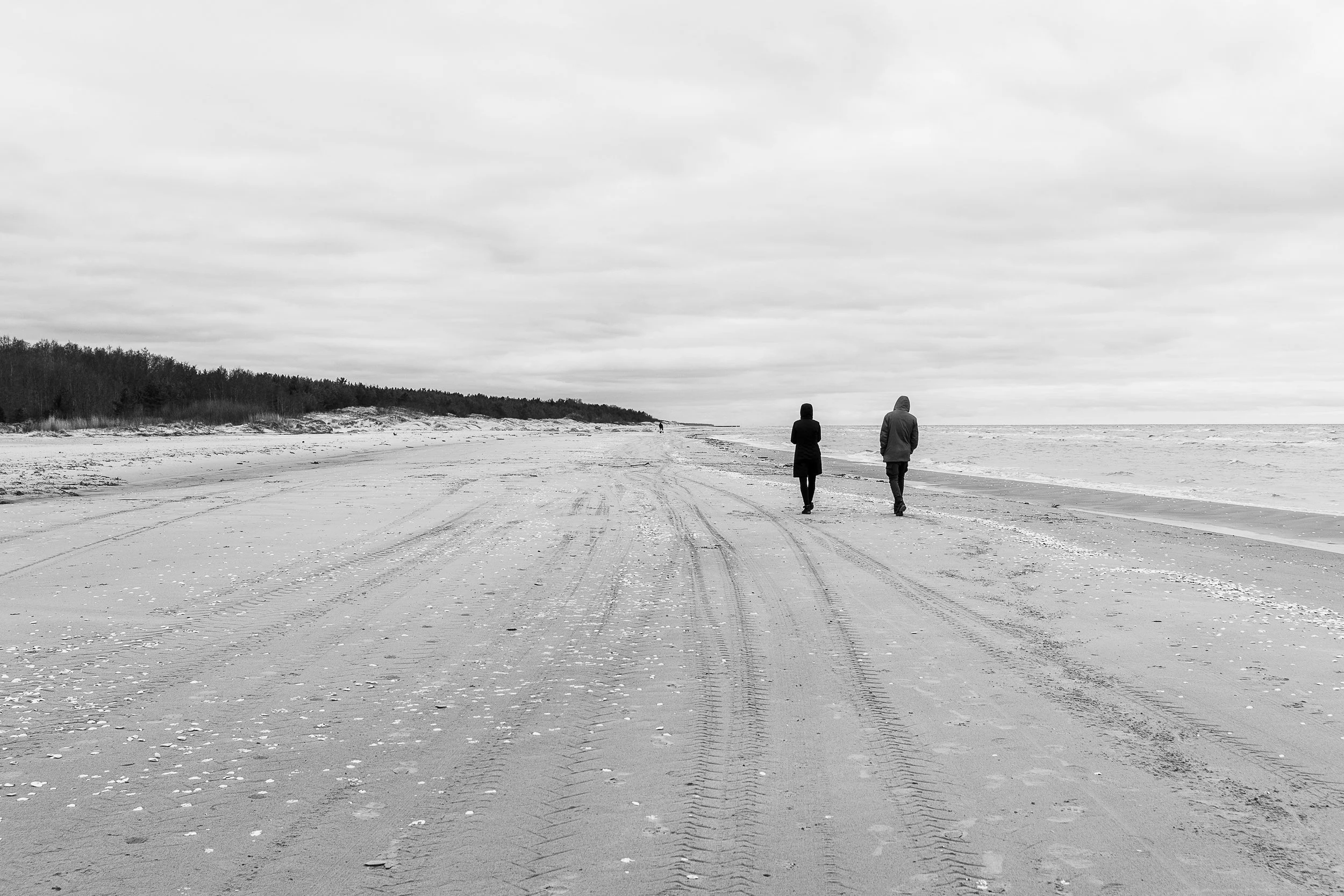
Spiritual Direction
As a Spiritual Director, I support clients in exploring their spiritual path, whatever that may be. This approach is particularly beneficial for individuals who are seeking to connect with the Source of life in creative and meaningful ways, overcome religious trauma, process some of the big existential questions in life, explore spiritual writings/concepts from around the world, deepen their spiritual practice, explore death & dying, and find greater peace, hope, and meaning in life.

-
Finding God in All Things....
One of the core sources of wisdom I draw upon is an Ignatian approach to spirituality which presupposes God can be found in all things. It invites us to seek the divine presence not only in sacred spaces but also in the ordinary moments of our lives — in our work, relationships, joys, and struggles. Ignatian spirituality teaches us to discern the presence of God in the midst of the ordinary, inviting us to cultivate a deep sense of mindfulness and gratitude for the sacredness inherent in every moment.Every soul carries a distinct spiritual narrative, and I honor the diversity of paths that bring seekers to my spiritual guidance. Whether you are navigating a period of spiritual desolation, seeking purpose and meaning, or longing for a deeper connection with the divine, I am here to support you. Together, we co-create a spiritual direction experience tailored to your needs, nurturing a sense of belonging and acceptance throughout our sacred journey. My approach encompasses the holistic well-being of your mind, body, and spirit. Drawing from the wisdom of Ignatian spirituality, we explore the Examen, inviting self-reflection and gratitude into your daily life. Through contemplative practices, we nurture mindfulness, promoting inner peace and serenity.
Additionally, I encourage the exploration of embodiment and nature, recognizing the divine presence in the beauty of the Earth, fostering a sense of ecological spirituality. Ignatian spirituality is not a destination but a continuous journey of transformation. It is wonderfully accessible and can be practically applied across a wide range of beliefs and worldviews. It is an invitation to encounter God intimately, to deepen our understanding of ourselves, and to live and love more fully.
-
Midlife Unravellings & Sacred Practices
The unique blend of spiritual direction I offer draws upon an eclectic array of ancient wisdom and modern contemplative practices. My approach is founded in the Jungian/Christian Mystic tradition yet I am very comfortable working with people from different faiths and spiritual perspectives. My goal is to create a safe and supportive space for the directee to explore their own spiritual journey. I strive to be empathetic and supportive, creating an environment where the directee feels free to share their deepest questions, concerns, and aspirations. Themes that clients may see me for include; deepening their spiritual practice and relationship with the Divine, career exploration, existential crisis, midlife unravellings, contemplating the meaning and purpose of life, coping with life transitions and challenges, cultivating compassion, finding solace & hope in the face of grief and loss, as well as working through spiritual crises & doubts and more. Drawing on the rich tradition of Jung and the mystics, I offer a variety of tools and practices to help you go deeper into your own spiritual journey, & supporting you as you discern the path you are called to journey. -
Rituals & Ceremonies
Here, the focus is around creating personalized rituals or ceremonies that help clients connect with their spirituality and move toward their therapeutic goals in a meaningful way. A ritual or ceremony can be defined as any intentional action that is performed in a symbolic or symbolic-physical way to help foster a connection between the inner and outer worlds. Examples of rituals and ceremonies that we might use include; lighting candles or incense, creating altars or sacred spaces, practicing mindfulness or meditation, engaging in contemplative prayer, walking a labyrinth, or performing more elaborate ceremonies or rituals to honour specific life transitions or defining events in the life of the client.
-
Creative Writing
Utilising the great stories of mythology, folklore and fairytales, creative writing can be a powerful tool for self-exploration, insight, and growth. These archetypal stories have been passed down through generations are deeply ingrained in our cultural consciousness. They often contain universal themes and symbols that can resonate with individuals on a deep level and provide insight and wisdom into their own lives. A client who is struggling with feelings of powerlessness and victimhood may use the story of Cinderella as a starting point for exploring their own experiences of oppression and resilience. By writing their own version of the story or using the characters and symbols in their own writing, the client can gain insight into their own patterns of behaviour and beliefs, and explore new ways of understanding and coping with their experiences
-
Soul Collage
Soul collage can be a very powerful and transformative tool for spiritual exploration. By using images that resonate with you on a deep level, we can tap into your intuition and connect with your inner wisdom. The process of creating a collage can be both meditative and creative, allowing you to access parts of yourself that may be difficult to express in words. During our sessions, we would work together to select images that represent different aspects of your psyche, including your strengths, challenges, desires, and fears. As you create your collage, we would explore the meanings behind each image and how they relate to your spiritual journey. Once your collage is complete, we would continue to work with it, using it as a tool for reflection and exploration. By delving deeper into the themes and patterns that emerge from your collage, we can gain a deeper understanding of your spiritual journey and the challenges and opportunities that lie ahead. Overall, soul collage is just one of the many tools that we can use in our work together. By combining different contemplative practices, mystical texts, and creative tools, we can create a personalized approach to spiritual direction that meets your unique needs and supports your growth and transformation.
-
Spiritual Direction through the Lens of MBTI
The Myers-Briggs Type Indicator (MBTI) is a personality assessment tool that was developed by Katherine Briggs and her daughter Isabel Briggs Myers in the early 20th century. Katherine Briggs was interested in the work of Carl Jung who developed the theory of psychological types, and she sought to develop a practical tool for identifying personality types based on his work. The MBTI was first published in 1943. The assessment has stood the test of time, it has been translated into more than 30 languages and is used by individuals and organizations in over 100 countries. Whilst the assessment is well established, detailed and informative, it is not a diagnostic test, but rather, a psychometric ‘indicator’. I utilise the MBTI in my spiritual direction practice and find it particularly applicable to clients who wish to explore their spirituality through this lens. It has rich applications for deepening the mystery of finding one’s purpose, vocational discernment, and the search for meaning. Clients receive a comprehensive computerised report on their type to take home to sustain their long-term growth & development. -
The Enneagram as a Map for Your Soul's Journey
The Enneagram is a personality type indicator that describes nine different personality types, each with their own patterns of thinking, feeling, and behaving. I draw on the Enneagram as a framework for understanding the unconscious patterns that influence our behaviour and limiting beliefs. In Jungian Coaching, we approach the Enneagram as a means of exploring the deeper motivations and fears that underlie our personality traits. In my coaching practice, I use the Enneagram to help clients identify their Enneagram type, as well as their core motivations and fears. By understanding their Enneagram type, clients can gain insight into their patterns of thinking, feeling, and behaving, and can begin to see how these patterns may be limiting their growth and potential. The Enneagram can be used to help individuals identify spiritual practices that align with their personality type. For example, a Type 5 may find meditation or contemplation helpful, while a Type 2 may find serving others to be a meaningful spiritual practice. I also explore with the client the shadow aspects of their Enneagram type. Through this, clients can gain insight into their own patterns of self-sabotage or limiting beliefs, and can begin to work towards greater self-awareness and integration. By using the Enneagram in spiritual direction, individuals can deepen their self-awareness and develop a more integrated and authentic sense of self. This can lead to greater inner peace, acceptance, and spiritual growth.Clients receive a comprehensive computerised report on their type to take home to sustain their long-term growth & development.
-
Walking the Labyrinth
I own two elegantly designed and resilient poly-nylon labyrinths, each measuring 14 feet in diameter, and featuring 5 circuits in the Chartres style. These labyrinths are instrumental in my facilitation of spiritual direction sessions for both individuals and small groups. The Chartres labyrinth is a circular labyrinth located on the floor of the nave of Chartres Cathedral in France. The labyrinth was constructed during the early 13th century, and it is one of the most famous examples of a medieval labyrinth. In terms of design, the Chartres labyrinth features a unicursal layout, consisting of a single path leading to and from the centre. The labyrinth represents the journey of the soul from the outer to the inner world, where one brings an intention, a question, a situation, or perhaps simply an openness to the moment. Every experience is different. When walking a labyrinth, people may experience a sense of peace, clarity, and heightened awareness as they reach the centre. This space is often viewed as a place of introspection, reflection, and connection to one's inner self or the divine. Some individuals may also receive a sense of spiritual or emotional refreshment, while others may experience a shift in perspective or gain insights into a particular situation or challenge in their lives. Ultimately, what one receives while in the middle of the labyrinth is unique to their individual experience and can vary from person to person. As a powerful symbol of life's journey, the labyrinth provides a space for contemplation, guidance-seeking, and gaining clarity for the road ahead.

“Maybe that is the difference between pastoral counselors and spiritual directors. We go to counselors when we want help getting out of the caves. We go to directors when we are ready to be led farther in.”
— Barbara Brown Taylor, “Learning to Walk in the Dark”. (2015)
